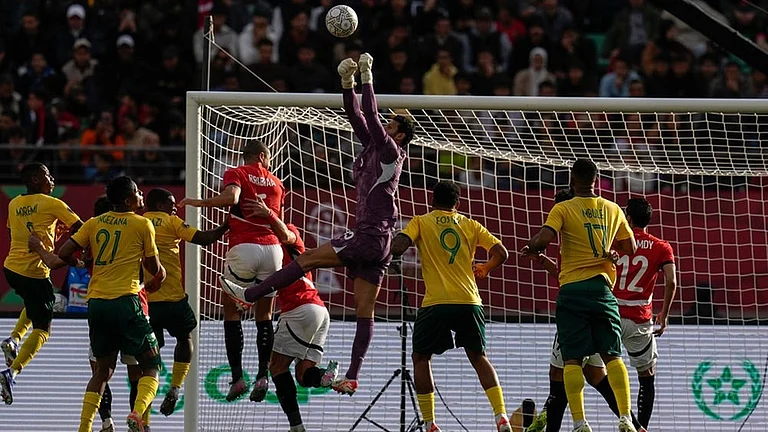On 10 November, 2021, the Union Cabinet declared 15th November, the eve of Jharkhand Diwas as the Remembrance Day for Birsa Munda and his contribution to India’s freedom struggle. Renewed interest in his memory fills the political landscape of India today. Birsa Munda is an iconic, legendary figure in Jharkhand. He is foremost an Adivasi, who later acquired various representations. He led the Birsa Ulgulan (rebellion) against British officials, upper caste zamindars and missionaries. A direct line might be drawn from that moment to the formation of modern Jharkhand. It is not surprising, then, that there is much at stake around the building of his statues in the state. The political life of Birsa Munda now thrives in political campaigns, gaining huge traction to memorialisation far removed from the lived realities of Adivasis.
The statues of Birsa Munda stand as an affective sites to recover, contest and represent memory. I have devised a conceptual lens of ‘material-memory’ to explain the burgeoning memory politics in Jharkhand. Material memory works as a collective noun to depict a wide range of objects that perform a mnemonic function, making people remember the past. However, this article uses it as a proper noun to articulate the potential of doing memory politics through objects in Jharkhand.
A statue of Birsa Munda is a ‘site of memory’. Given the official canonisation of Birsa as Shahid (martyr) and Bhagwan (God), these statues reflect the complicated relationship between the sacred, aesthetic and the political. It illustrates a process of ‘disciplining memory’ that temporalises the past of Birsa integrating with the tourism industry and the political aesthetic.
I suggest that the statue of Birsa Munda is primarily a political text that mediates the political life of memory. It occupies distinct temporality – where the history of the subject becomes a permanent present. Birsa Munda’s statue offers a vivid reflection of his struggle as a ‘permanent present’. His statue as the political text allows politicians to inscribe their version of the Adivasi past. The sites of the statues, in turn, are sites of contestation of power that lend political strength primarily to non-Adivasi leaders.
Birsa is foremost an Adivasi, who made a clear clarion call ‘Abua disum, Abua raj’ (‘My village, My rule’). Increased representations within the mainstream dilute this primal thrust of the Adivasi movement that is tied to securing jal, jungal aur jameen.
Snapshot of his life
Born into a low-income family of a peasant on 15 November 1875 in Chhota Nagpur region of Eastern colonial India, Birsa Munda soon acquired recognition for his dynamic personality and political preaching. He spent the early years of his life in severe poverty and a massive scale of interference with the Adivasi livelihood in the region. Against the systemic exploitation by the dikus (outsiders), he mobilised people with his charismatic personality, often combining the characteristics of messianic and revolutionary ideology. Following the years after his dropping out of school, Birsa went to jail for his political activities that targeted the authorities. However, he succeeds in awakening the political consciousness amongst his people. Gradually at the end of the 19th century, he organised a rebellion against the colonial state, missionaries and zamindars, what came to be known as the Birsa Ulgulan.
The movement marked a massive shift in the approach of the colonial government towards the land issue. The Chhota Nagpur Tenancy Act (CNTA) was enacted under the guidance of Hoffman, whose significant role is evident in the making of the legislation. However, the movement also produced a massive cultural milieu amongst the Adivasis. The cultural milieu lent a language of indigenous claims of the regional movement for the formation of a separate state called Jharkhand. It was formed 120 years after Birsa’s death.

The movement for the state involved a competing political interests and ideologies based on claims of ethno-regional identity, environmentalism and the politics of mineral resources, among other factors. The formation of the state followed a series of movements. Not only has the political instability jeopardised the interest of those who have historically fought (Adivasi) against outsiders, it continues to seasonably affect protectionary legal legislations such as the CNTA.
Burgeoning interest in his memory heightened as Jharkhand secured statehood, attracting non-Adivasis, often politicians, to mobilise it. Competing ideologies from all ends of political spectrum began to claim Birsa. Often, the aesthetic display in the built environment, statues in particular, become the medium to articulate a political vision. Politicians found an opportunity to speak for Adivasis through the medium of aesthetic.
Memory as struggle of power
During my research, I met MLA Sudesh Mahto from the BJP, who was in the process of building a Birsa Munda statue. Mahto failed to secure a stable ideological standpoint both within the alliance and outside as a party. He has made a concerted effort to address the concerns of Adivasis through symbolic articulations by commissioning a forum called Ulgulan Foundation, named after the rebellion. It is also significant because of the scale and processes in installing the statue. It is located on the National Highway 33 (Ranchi-Jamshedpur) as the process of land donation has ended. It would be 150 feet tall in size.
My meeting with Dayamani Barla, an activist who has been fighting against industrial projects in Jharkhand for decades now, was a study in contrast. Instead of referring to a schematic description of the Adivasi past, as evident in my interview with Mahto, Barla underlined a pressing issue that defines Jharkhand – the struggle of ‘Jal, Jungal, Jameen.’ Barla suggests that the form of the Raj has changed, allowing newer kinds of oppression and extraction that dispossess the Adivasis of their land and heritage. When Barla invokes imperial rule, it is not anachronistic. The representation of the past and the reality of the present coincide.
In 2016, the BJP government announced the removal of the jangir, the handcuffs, from the Birsa Munda statue installed at Birsa Chowk in Ranchi. The government argued it ‘cast a negative image for the youth’ and it was noted by the Deputy Commissioner that ‘people should not read too much into it, insisting that the freedom fighter should not be chained’. Barla was not impressed. She said: “Unleashing the handcuffs, I felt was unsolicited. His jangir was a symbol of our struggle. […] When we as Adivasis used to look at the handcuffs, we used to feel inspired that we need to fight the new form of slavery, a new mode of oppression under the ambit of the global market. We need to break the chains that tie us to injustice. I said it then against those who advocated unchaining the jangir – if you really wish to take away the handcuffs, you must do it in the material form of independence. The material independence lies in implementing Schedule 5, CNTA, SPTA, as per the Constitution of India. The symbolic gesture of unshackling the chains is theatrical at best. It serves the politics of appeasement. Respecting Schedule 5 is important to everyone who lives under the gaon sabha (village assembly) irrespective of his or her caste, class and gender. It is our right that predates the Constitution…You cannot change history. Histories that reflect that were written with oppression and subjugation. The symbolic act of taking off the handcuffs is futile. Our frustration is bottled up.”
I travelled to Ulihatu, considered the birthplace of Birsa Munda, due to which it has a steady stream of visitors, mainly politicians who do nothing for the village. Billboards of politicians promising upliftment litter the walls, in stark contrast to the impoverished lives of the people. It hosts a lavish statue of Birsa, painted in gold, bearing no aesthetic or cultural resonance for the Adivasis. The Adivasis there live in absolute precarity. What might this statue mean to them?
These three sites show us the ways in which Birsa Munda is remembered and perhaps dismembered. It is really a tussle between the state, which controls most of the memory-making, and the Adivasis, for whom he is a figure with whom they are continually in dialogue.
(This appeared in the print edition as "Material Memory")
(Views expressed are personal)
Rahul Ranjan the writer is a postdoctoral research fellow at the OSLO Metropolitan University, Norway





















